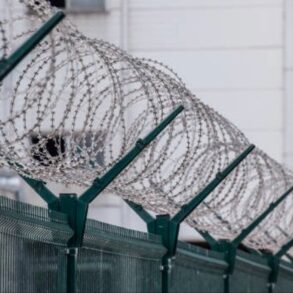With this series of weekly updates, WOLA seeks to cover the most important developments at the U.S.-Mexico border. See past weekly updates here.
Your donation to WOLA is crucial to keeping these paywall-free and ad-free Updates going. Please contribute now and support our work.
THIS WEEK IN BRIEF:
- El Salvador renditions reach the Supreme Court: The Supreme Court made two rulings related to the Trump administration’s practice of sending migrants to a mega-prison in El Salvador. The first requires that people subjected to rapid expulsion under the Alien Enemies Act have a reasonable chance to defend themselves. The second upholds, though softens, a lower-court judge’s requirement that the administration seek the release and return of a wrongfully expelled Salvadoran man. The President of El Salvador is to visit Washington on April 14.
- Evidence points to little criminality among those rushed to El Salvador’s mega-prison: As experts cast doubt on tattoos as a sign of Venezuelan gang membership, three studies indicate that a substantial majority of those rendered to El Salvador had no known criminal records.
- A $45 billion bill for migrant detention foreseen as budget bill moves slowly through Congress: A request for proposals issued to contractors foresees ramping up migrant detention spending sixfold, to $45 billion over two years. That would be paid for by a giant one-time appropriation slowly working through the Republican-majority Congress, which cleared an important initial hurdle this week.
- New measures to undo legal pathways and punish the undocumented: This week saw CBP One app recipients receive an order to self-deport, a proposal to fine migrants up to $998 per day if they stay after receiving removal orders, movement toward a registry of undocumented migrants, and a continued legal fight over Temporary Protected Status (TPS) for Venezuelans.
- A woman dies by suicide in Border Patrol custody as internal oversight is decimated: A female citizen of China died by suicide in a California Border Patrol station. This and other recent incidents raise questions about oversight at a time when the Trump administration has effectively closed down the Department of Homeland Security’s (DHS) internal investigative agencies.
- Notes on the impact in Mexico: Media reports covered the situation of migrants stranded in Mexico by the Trump administration’s revocation of asylum access at the border, including Venezuelans requesting repatriation flights and Haitians who are especially vulnerable to harm.
THE FULL UPDATE:
El Salvador renditions reach the Supreme Court
Alien Enemies Act
In a 5-4 ruling issued on the evening of April 7, the U.S. Supreme Court permitted the Trump administration to continue using a rarely invoked 18th-century wartime law to remove migrants whom it believes are members of a Venezuelan criminal group, and then send them to a sprawling prison facility in El Salvador. The Court, however, added due process protections that the Trump administration had not applied when it rapidly sent hundreds of Venezuelan people to El Salvador in mid-March.
The renditions of suspected “Tren de Aragua” members may continue, the justices ruled, while lower courts consider the legality of the White House’s March 15 proclamation invoking the 1798 Alien Enemies Act for the fourth time in U.S. history. That order justified this very rare step with a claim that the United States is suffering a “predatory incursion” from the Venezuelan government in league with the criminal organization. The administration used this power to remove about 137 Venezuelan men without any chance to defend themselves, and sent them to El Salvador’s Center for Confinement of Terrorism (CECOT), a facility built in 2023 that can hold more than 40,000 prisoners.
The Supreme Court did not rule on the “predatory incursion” claim or the pipeline to the CECOT, which remain before lower courts. It did rule, however, that the administration could no longer use the Alien Enemies Act against people without first notifying them and permitting them to file writs of habeas corpus, which require that they be brought before a court to determine if their detention is lawful. The judges ruled that those writs must be filed in the jurisdictions where people are detained.
When it first invoked the Alien Enemies Act on March 15, the Trump administration did not do that. Immigration and Customs Enforcement (ICE) whisked detained Venezuelan men onto El Salvador-bound planes within minutes of the White House proclamation’s publication, and with only a vague sense that it had sought to verify their membership in Tren de Aragua.
Those planes carried 261 people from Venezuela and El Salvador, including many with final removal orders and not subject to the 1798 law. They went to El Salvador despite a temporary restraining order, issued while they were in the air, from Washington DC District Court Chief Judge James Boasberg. That order, extended once, is what the Supreme Court overturned on April 7.
Lower courts may still consider questions about the legality and propriety of using the wartime statute and Salvadoran prisons in the first place. On April 7, the Supreme Court ruled only on whether Judge Boasberg could halt all use of the Alien Enemies Act through a restraining order. The New York Times called it “a narrow procedural ruling.”
The CECOT
Including 17 more people sent on March 30, the administration has transferred 278 people (whom we know of) to the CECOT. Two hundred forty-five are Venezuelan, and 33 are Salvadoran. The Venezuelans include the reported 137 removed under the Alien Enemies Act.
They are in a prison with strict discipline and extreme austerity. No prisoner has ever been released from the CECOT facility, and their contact with the outside world, including attorneys, is nearly zero, even though much of its inmate population is still awaiting trial. ACLU attorney Lee Gelernt told “60 Minutes” that “there’s a real danger” that the men in the CECOT might never see their families again.
Citing media reports, attorneys for Kilmar Abrego Garcia, a Salvadoran man wrongfully sent to the CECOT whose case is discussed below, described conditions in the mega-prison:
Each of the 256 cells is intended to hold approximately 80 inmates but often holds nearly double. The cramped cells are equipped with tiered metal bunks without mattresses, two basins for washing, and two open toilets. There are no windows, fans, or air conditioning, despite the region’s warm and humid climate.
Inmates in CECOT are confined to their cells for 23.5 hours daily and cannot go outdoors. They are denied access to reading materials, including even letters from friends or family. Inmates are prohibited from receiving visits from family and friends. Meals are provided through the bars, and the facility enforces strict regulations to maintain order.
Habeas claims
The decision gives people the right to a “meaningful opportunity” to have their cases reviewed before the Alien Enemies Act is applied to them, which ACLU attorney Gelernt called “a huge victory.”
However, those reviews must occur in the jurisdiction where ICE is holding them, often in states with the most conservative federal judges, like the Fifth Circuit, which encompasses Texas and Louisiana. “I don’t think I’m speaking out of school when I suggest that there is no court in the country more likely to side with the Trump administration on everything from whether we’re under an ‘invasion’ from Tren de Aragua to the amount of process to which alleged members of TdA are entitled,” wrote Steve Vladeck of the Georgetown University Law Center. Unlike Washington DC courts, those jurisdictions also have less experience with foreign policy and national security matters.
The Court also did not specify how people might pursue their habeas claims while detained, perhaps without attorneys. “Detainees scattered across the country must each obtain counsel and file habeas petitions on their own accord, all without knowing whether they will remain in detention where they were arrested or be secretly transferred to an alternative location,” noted the dissenting opinion of Justices Sonia Sotomayor, Elena Kagan, and Ketanji Brown Jackson.
Following the Supreme Court’s ruling, attorneys in Texas and New York won temporary restraining orders from judges at least partially protecting clients from removal under the Alien Enemies Act. Other legal actions may follow as attorneys seek to protect clients using the review opportunity that the Supreme Court decision provides, the Washington Post reported.
The Abrego Garcia case
The Supreme Court’s April 7 decision did not specify whether or how a person can make a habeas corpus claim from a foreign prison, after being removed from the United States. That question is front-and-center in the case of Kilmar Abrego Garcia, a Salvadoran citizen who is now in El Salvador’s CECOT prison even though he was protected from deportation to El Salvador after 14 years in the United States, held a U.S. work permit, and is guilty of no crime. ICE acknowledged in a court declaration that Abrego Garcia’s removal was an “administrative error” and an “oversight.”
In documents and statements, Trump administration officials repeatedly insist that Abrego Garcia is a “verified” and “prominent” member of El Salvador’s MS-13 gang, as a brief filed before the Supreme Court put it. In fact, Maryland District Court Judge Paula Xinis, who considered his case, noted: “The ‘evidence’ against Abrego Garcia consisted of nothing more than his Chicago Bulls hat and hoodie, and a vague, uncorroborated allegation from a confidential informant claiming he belonged to MS-13’s ‘Western’ clique in New York—a place he has never lived.”
Fourteen years after coming to the United States at the age of 16, Kilmar Abrego Garcia had just one arrest in 2019. It was for loitering in a Home Depot parking lot, where he aimed to get hired as day labor.
Pema Levy wrote at Mother Jones that what happens to him now “could pose a make or break moment, not just for the life of Abrego Garcia, but for what kind of country we are going to be.”
Judge Xinis ordered on April 4 that Abrego Garcia be returned to the United States by 11:59 PM on April 7. Judge Xinis reinforced her order with a strongly worded opinion on April 6, as the Trump administration sought to get the Fourth Circuit Court of Appeals in Washington to overturn it. The appeals court upheld Xinis’s April 7 deadline by a 3-0 vote.
The Justice Department lawyer defending the administration’s opposition to bringing Abrego Garcia back, Erez Reuveni, recognized that he was deported in error and seemed to lack basic information to respond to Judge Xinis’s inquiries. “I’m also frustrated that I have no answers for you for a lot of these questions,” he told the judge. “I have not received today an answer that I find satisfactory,” Reuveni added, to the question of why the administration cannot retrieve him from El Salvador.
On April 5, the Trump administration put Reuveni, a veteran Justice Department attorney in immigration-related cases, on indefinite leave for failing to “follow a directive from your superiors” to “zealously advocate,” the New York Times and CNN reported.
The Trump administration quickly asked the Supreme Court to put a hold on the lower courts’ demand that it seek Abrego Garcia’s return. In its April 6 appeal, the administration argued that even when someone is deported and imprisoned in El Salvador by an admitted mistake, the federal courts do not have the power to do anything about it. On April 4, White House Press Secretary Karoline Leavitt said, “We suggest the judge contact [Salvadoran] President Bukele because we are unaware of the judge having jurisdiction or authority over the country of El Salvador.”
Following a several-day pause of Judge Xinis’s order for Abrego Garcia’s return, on April 10 the Supreme Court softened that order but essentially upheld it. By a 9-0 decision, the Court agreed that Abrego Garcia’s rendition to El Salvador was “illegal,” and instructed the Trump administration “to ‘facilitate’ Abrego Garcia’s release from custody in El Salvador and to ensure that his case is handled as it would have been had he not been improperly sent to El Salvador.” However, it threw back to Judge Xinis the definition of how to require the administration to “effectuate” his release, “with due regard for the deference owed to the Executive Branch in the conduct of foreign affairs.”
Compelling retrieval from El Salvador
“The Trump administration could potentially argue the Salvadoran government does not want to release Abrego Garcia from prison, and say there’s nothing the U.S. can do,” warned reporter Camilo Montoya-Gálvez of CBS News. Indeed, White House Deputy Chief of Staff Stephen Miller took to Twitter on the evening of April 10 to say that it is “false” that the Supreme Court has required the administration to bring the Salvadoran man back, arguing that the justices respected the presidency’s foreign affairs powers and “the illegal alien terrorist [Abrego Garcia] is in the custody and control of a sovereign foreign nation.”
Despite Miller’s implication that the administration cannot do anything to bring Abrego Garcia back, it is not unusual for the U.S. government to ask a foreign government to return someone who was removed by mistake.
Between fiscal 2015 and the second quarter of fiscal 2020, the Government Accountability Office (GAO) reported, ICE mistakenly removed U.S. citizens from the United States 70 times. Georgetown’s Vladeck observed that, following 2012 litigation and an ICE directive that year, “the government already has a procedure in place for taking steps to return at least some individuals who have been wrongly removed.”
The argument is also odd in this case because the U.S. government is paying the Salvadoran government a reported $6 million over the next year to detain Abrego Garcia and the other Venezuelan and Salvadoran citizens sent there.
Application to U.S. citizens?
Numerous analyses pointed to the ominous possibility that if permitted to leave Abrego Garcia in the CECOT, the Trump administration could, in future, subject U.S. citizens, perhaps including political opponents, to similar “mistakes.”
- In a dissenting opinion in the April 7 Alien Enemies Act case, Justice Sonia Sotomayor wrote: “Not only noncitizens but also United States citizens could be taken off the streets, forced onto planes and confined to foreign prisons with no opportunity for redress if judicial review is denied unlawfully before removal. History is no stranger to such lawless regimes, but this nation’s system of laws is designed to prevent, not enable, their rise.”
- “The government could whisk individuals to foreign prisons in violation of court orders and then contend, invoking its Article II powers, that it is no longer their custodian, and there is nothing that can be done,” warned Judge James Wilkinson, a Reagan appointee, in a concurring opinion in the Fourth Circuit Court of Appeals’ decision in the Abrego Garcia case. “It takes no small amount of imagination to understand that this is a path of perfect lawlessness, one that courts cannot condone.”
- “There would be nothing to stop the government from jailing its critics in another country and then claiming, as it is now, that the courts have no jurisdiction to remedy the situation,” wrote law professors Erwin Chemerinsky of the University of California at Berkeley and Laurence H. Tribe of Harvard University, at the New York Times. “The administration could create its own gulags with no more judicial review than existed when Stalin did the same thing in the Soviet Union.”
- Together with Harvard Professor Martha Minow, Chemerinsky and Tribe echoed this warning in an amicus brief before the Supreme Court in the Abrego Garcia case: “the Executive Branch would possess a shuddering degree of power—power that the President could wield in extreme and extraordinary ways, including against American citizens that the President simply disfavors.”
- “A world in which federal courts lacked the power to order the government to take every possible step to bring back to the United States individuals like Abrego Garcia is a world in which the government could send any of us to a Salvadoran prison without due process, claim that the misstep was a result of ‘administrative error,’ and thereby wash its hands of any responsibility for what happens next,” wrote Steve Vladeck of the Georgetown University Law Center. “Rather than providing fodder for snarky comments from the White House Press Secretary, that possibility should terrify all of us.”
- On April 8, White House Press Secretary Karoline Leavitt mused about sending U.S. citizens to the CECOT. While clarifying that she was referring to hardened criminals, she stated, “The president has said if it’s legal, if there’s a legal pathway to do that, he’s not sure, we are not sure if there is, it’s an idea that he has simply floated and has discussed.”
- “Here we have a foreign president who has openly said he would take U.S. citizens the U.S. wanted to send there—and an administration that has been very heavily flirting with the idea,” the American Immigration Council’s Aaron Reichlin-Melnick told the New Republic’s Greg Sargent.
El Salvador’s president to visit Washington
The founder of the CECOT prison and architect of a sweeping security crackdown in El Salvador is the nation’s popular but authoritarian president, Nayib Bukele. An ally of the Trump administration, Bukele tweeted a cartoon image of an angry Snowball the Rabbit, a character from the animated film Secret Life of Pets, in response to Judge Xinis’s suggestion that Garcia Abrego should be released and returned to the United States.
Bukele will be in Washington on Monday, April 14, for a “working visit,” the White House announced. He is expected to discuss further use of the CECOT prison to confine people removed from the United States.
CNN, citing three sources, reported that Erik Prince, founder of the highly controversial private security company Blackwater, has pitched administration officials on an idea “to set up a US-run immigrant detention facility in El Salvador to detain immigrants with criminal records.”
On April 8, acting ICE Director Todd Lyons told reporters that the Trump administration plans to expand the use of the Alien Enemies Act beyond Tren de Aragua to encompass members of the Salvadoran gang MS-13, the Associated Press reported. That is the only available information about a possible expansion of the Alien Enemies Act, and it is unclear whether any announcement might coincide with Bukele’s visit.
Evidence points to little criminality among those rushed to El Salvador’s mega-prison
A Guantánamo alternative
According to CNN, administration officials are finding use of the CECOT to imprison migrants to be much easier than sending them to the U.S. Naval Station at Guantánamo Bay, Cuba, as President Trump had first ordered at the end of January. (“Guantanamo is a PR statement that they have to figure out how to get out of. Logistically, it was a nightmare,” a “source familiar with the discussions” around the base told CNN.)
The Salvadoran facility may offer legal ambiguities that the Trump administration could exploit, wrote journalist Spencer Ackerman at Forever Wars. “CECOT is an opportunity for the Trump administration to have what the Bush administration meant Guantanamo Bay to be: a place truly beyond the reach of the law. It represents a reset to the ambitions of the first stage of the War on Terror, one that learned from the reversals of the subsequent stages.”
As of April 4, ICE was housing 45 migrants at Guantánamo Bay, 35 of them in the “Camp 6” military prison facility, the New York Times reported, noting that the administration has transferred detainees from Guantánamo to Venezuela, El Salvador, and Nicaragua (44 Nicaraguans went to Managua on an April 3 ICE charter flight). The Times noted that the Defense Department spent $3 million setting up 195 tents on the base grounds, which will not be used due to safety and security concerns.
Doubts about Tren de Aragua membership and influence
Evidence continues to emerge that casts doubt on the majority of imprisoned Venezuelans’ alleged gang ties. A March 28 ACLU filing included a copy of a rubric of criteria that ICE agents have used to determine whether they suspect that a migrant may be a member of Tren de Aragua. This “Alien Enemy Validation Guide” set up a scoring system that could identify someone as a member of the group based solely on tattoos and “insignia, logos, notations, drawings, or dress.”
That rubric “doesn’t appear to be designed to do a careful vetting. It appears to be designed to make sure that they have a steady stream of people that they could claim are Tren de Aragua members and therefore eligible for [removal under] the Alien Enemies Act,” former Department of Homeland Security (DHS) official Deborah Fleischaker told Isabela Dias of Mother Jones.
Experts state that the criminal group does not even use tattoos and rarely uses common iconography. “The designation of tattoos as a gang identifier presumably stems from the practice of Central American gangs to indicate membership with tattoos, but our research suggests that Tren de Aragua, and Venezuelan gangs more generally, do not have a history of doing so,” pointed out longtime Venezuela security experts Rebecca Hanson, David Smilde, and Verónica Zubillaga at the New York Times. “Many young Venezuelans, like young people everywhere, borrow from the global culture of iconic symbols and get tattoos. That doesn’t mean they’re in a gang.”
“Tren de Aragua is not invading America,” they added. “Researchers have seen no evidence that it has organized cells in the country that cooperate with one another, much less receive directions from abroad.” Hanson, a criminology professor at the University of Florida, also made these arguments in an expert declaration in the Alien Enemies Act case. That document notes that Tren de Aragua “has become increasingly fragmented and decentralized since 2023, further limiting its capacity.”
Lack of criminal records
Three different investigations now point to the indiscriminate nature of the Trump administration’s March arrests and expulsions to the CECOT of Venezuelan people under the Alien Enemies Act. It increasingly appears that actual membership in Tren de Aragua may have been the exception among those flown to El Salvador.
1) The CBS News investigative program “60 Minutes” reported being unable to find a criminal record for 75 percent of the 238 Venezuelan men sent to El Salvador on March 15. Of the 22 percent who clearly did have criminal records, most offenses were “non-violent, such as theft, shoplifting, and trespassing,” with about a dozen charged with more serious violent crimes.
The program told the stories of some of those now in the CECOT, focusing primarily on Andry Hernández Romero, a gay makeup artist with an asylum case, whom ICE apparently decided was a Tren de Aragua member because he had tattoos. The report included new images of Hernández being taken into the CECOT, where guards shaved his head and slapped him while he prayed, from photojournalist Philip Holsinger.
A USA Today investigation revealed that ICE based its allegations of Hernández’s gang membership on the testimony of a fired Milwaukee police officer turned private detention-center contractor employee whose credibility is so questionable that Milwaukee County prosecutors “flagged him on a list of police who had been accused of lying, breaking the law or acting in a way that erodes their credibility to testify.”
Gavin Newsom, the governor of California, where Hernández was living, wrote to DHS Secretary Kristi Noem on April 10 asking her to intercede for his release and return.
2) A Bloomberg examination of the 238 Venezuelans sent to El Salvador on March 15 found just 10 of them with felony or misdemeanor charges or convictions. “For the rest of the men, there was no available information showing they committed any crime other than traffic or immigration violations in the US.” The article concludes that about 90 percent had no U.S. criminal record.
3) The Salvadoran human rights defense NGO Cristosal published findings from relatives of 94 of the Venezuelan prisoners, shared by Migrant Insider. Of that sample, only 12 or 13 percent have criminal records. The 94 ranged in age from 18 to 41; 78 percent were employed, and 87 percent had tattoos. Seven percent have a disability, and 22 percent have chronic illnesses that are unlikely to be treated. Their detentions occurred in many states, but most often in Texas.
Despite this evidence, DHS Secretary Kristi Noem said on April 9, “We’re confident that people that are [imprisoned in El Salvador] should be there, and they should stay there for the rest of their lives.”
A $45 billion bill for migrant detention foreseen as budget bill moves slowly through Congress
Large-scale detention ambitions
“We need to get better at treating this like a business,” Acting ICE Director Todd Lyons told a conference of border security equipment vendors in Phoenix, speaking about his agency’s deportation operations. Lyons said he wants trucks rounding up deportees “like (Amazon) Prime, but with human beings.” Lyons added that he hopes to see ICE using artificial intelligence to “free up bed space” and “fill up airplanes” more efficiently.
The Arizona Republic observed that the number of ICE detainees is now at its highest point since November 2019. The agency’s detained population increased 22 percent from 38,714 to 47,304, from October to March. As the agency’s budget is enough for 41,500 detention beds, many detention centers are overcrowded.
The Washington Post reported that a growing number of U.S. citizens are among those being detained, and perhaps even deported, by ICE’s increasing tempo of operations. Data analysis from Jacqueline Stevens, a political science professor at Northwestern University, estimates that up to 1.5 percent of ICE deportees since 2007 have been citizens.
“We need to buy more beds, we need more airplane flights and I know a lot of you are here for that reason,” White House “Border Czar” Tom Homan told the “Border Security Expo” attendees in Phoenix. New details about detention contracting are shedding light on the potential scale of this operation.
A giant detention contract
The New York Times revealed that on April 1, ICE had posted a request for proposals for “emergency detention and related services” contracts totaling a staggering $45 billion over two years. By comparison, the agency’s most recent appropriation (2024) gave it $3.435 billion to fund one year’s detention: one-sixth of the amount proposed in the new document. The request gave potential contractors three days to submit bids, indicating that ICE plans to expand detention very quickly.
The Times observed that the request does not call for the same detainee care standards that ICE’s larger contractor-run facilities must normally meet. “Instead, they can operate under the less rigorous standards the agency uses for contracts with local jails and prisons.” As discussed below, DHS has also just shuttered a critical internal watchdog for detainee welfare, the Office of the Immigration Detention Ombudsman (OIDO).
The “reconciliation” bill
ICE does not yet have this funding. It would have to come through a special appropriation working its way through Congress, where President Trump’s Republican Party holds majorities in both houses. This massive spending measure is known as the “reconciliation” bill from the name of the special Senate procedure that would allow it to pass without a filibuster, and thus without a single Democratic vote.
On April 4, the U.S. Senate passed a budget resolution that must serve as an outline or framework for the subsequent, more detailed “reconciliation” bill. In order to move forward on the larger bill, the House and Senate must pass identical budget resolutions.
The U.S. House of Representatives passed an identical companion resolution on April 10 by a 216-214 vote, overcoming objections from members demanding deeper spending cuts to offset the resolution’s big new proposed expenditures.
This framework bill instructs congressional committees to write up a “reconciliation” funding bill detailing how they would spend the new money, and what they might cut to offset some of the new spending. The timing of this bill is unclear: though the White House wants it passed as soon as possible, strong disagreements among Republicans about taxes and spending cuts could delay it for weeks or months. So could procedural tactics from the Democratic minority.
The budget resolution calls for providing DHS, ICE’s parent agency, with an additional $90 billion to $175 billion over the next 10 years.
The yearly addition would be enormous: $175 billion—an annual average of $17.5 billion per year—would be roughly equivalent to the current combined yearly budget of ICE and Border Patrol.
Most of it—including the $45 billion for detention over two years—would pay for the Trump administration’s “mass deportation” plans. So would parts of similarly large outlays in the bill for the Justice and Defense Departments: some Defense money could support additional detention at military bases, for instance.
It would also pay for vastly expanded deportation flights to other nations. In his latest monthly report on ICE flights, Tom Cartwright of Witness at the Border observed that these flights’ tempo, so far, has not increased dramatically: the 6.4 removal flights per weekday in March would have been on the high end of the daily averages measured during the Biden administration. The new money would sharply change that.
New measures to undo legal pathways and punish the undocumented
USA Today highlighted the Trump administration’s ongoing wave of reversals of Biden-era policies that had created some legal pathways for migrants to enter the United States, both at the border and by avoiding the border. Presidential actions can create initiatives like Temporary Protected Status grants, humanitarian parole, and CBP One appointments—but presidential action is all that is required to dismantle them. “Immigrant advocates argue that those who entered through these programs followed the rules and are now left vulnerable,” noted reporter Lauren Villagrán.
Among examples reported this week are the following.
- Many migrants who arrived in the United States with appointments made at ports of entry using the CBP One app, under a 2023-2024 Biden administration policy, are receiving emails notifying them that their parole status in the United States will be revoked within seven days and that they must leave the country “immediately,” the Associated Press and CBS News reported. Between January 2023 and December 2024, more than 936,500 people arrived in the United States via CBP One appointments.
- Documents obtained by Reuters revealed Trump administration plans to charge migrants fines of up to $998 per day if they do not leave the United States after receiving deportation orders, and to seize their property if they fail to pay. The policy would be based on a 1996 law. “The White House National Security Council and Stephen Miller, deputy chief of staff for policy, have been pressing Customs and Border Protection (CBP) to administer the fines and handle seizures, a CBP official wrote in a March 31 email,” Reuters reported. CBP later recommended that ICE take on this responsibility.
- A Washington DC district court judge struck down a lawsuit from the Coalition for Humane Immigrant Rights, the United Farm Workers, and other groups that had sought to stop the Trump administration from requiring undocumented migrants to register with the federal government. The administration has drafted a rule requiring that registry, with criminal penalties for those who fail to identify themselves, drawing from a disused 1940s law. After 30 days, anyone who fails to register will face daily fines upon arrest, DHS Secretary Noem said on April 8. Judge Trevor N. McFadden, a Trump appointee, ruled that the plaintiffs lacked standing to show the registry rule would harm them.
- On April 4, the Trump administration filed an emergency appeal of a California judge’s March 31 decision keeping Temporary Protected Status (TPS) in place for about 350,000 Venezuelan citizens in the United States, which the administration had sought to cancel early. The Venezuelans’ status would have expired on April 7.
A woman dies by suicide in Border Patrol custody as internal oversight is decimated
A 52-year-old female citizen of China died by suicide while in custody in Border Patrol’s Blythe Station, in the California segment of the agency’s Yuma Sector, in the early morning of March 29. The incident was first revealed by Rep. Pramila Jayapal (D-Washington), a frequent immigrants’ rights advocate, and reported in an April 8 CBP statement.
CBP reported that the woman, who had overstayed her visa and was apprehended at a Border Patrol vehicle stop, hung or strangled herself with a strip of mylar torn from one of the disposable plastic blankets that Border Patrol commonly distributes to people held in its stations. The agency claims that, according to footage, she went behind a partition that gives some privacy to those using the cell’s toilet facilities, which placed her out of camera view. A Border Patrol processing coordinator found her over an hour later.
“Initial reports have indicated that certain CBP procedures to ensure the safety and welfare of individuals in custody were not conducted,” Rep. Jayapal wrote on April 2. “There is no excuse for why agents cannot verify if some of the necessary welfare checks occurred.”
Eliminating internal oversight agencies
On March 21, DHS effectively shut down its Civil Rights and Civil Liberties (CRCL) office, which investigates complaints of abuse and issues recommendations. While the office, which is established by statute, still formally exists, most of its 150-person staff were fired. “As a result, about 600 civil rights abuse investigations were frozen,” ProPublica reported.
Forty-nine Democratic members of the U.S. House of Representatives sent a letter demanding that DHS Secretary Kristi Noem immediately restore CRCL, as well as the Department’s ombudsman’s offices for detention (OIDO) and for U.S. Citizenship and Immigration Services (USCIS). Led by Rep. Debbie Wasserman Schultz (D-Florida), the letter cites recent human rights allegations about alarming conditions in the Krome Detention Center on Miami’s western edge.
At Democracy Journal, former CRCL Officer Margo Schlanger, now a law professor at the University of Michigan, documented the oversight body’s history and congressionally mandated growth since DHS was founded in 2023. “Shutting down DHS’s watchdog offices flouts numerous congressional enactments,” Schlanger warned. “As in so many other areas, the Administration is asserting anti-constitutional authority to disregard the law.”
“Between 2017 and 2024, CBP reported that more than 1,100 agents were terminated, resigned or retired under investigation for problematic behavior or a criminal conviction, or that there were substantiated complaints against them of serious misconduct,” recalled a column from former DHS inspector-general John Roth and Sarah Turberville of the Project on Government Oversight. They warned, “The problems with CBP, a force larger even than the New York City police, are likely to get worse after the Trump administration decimated the agencies that investigated CBP mistreatment of citizens and noncitizens alike.”
CNN reported that other parts of DHS, including CBP and ICE, could suffer staff cuts as the Trump administration’s so-called Department of Government Efficiency (DOGE) turns its attention to the Department.
Other recent oversight cases
CalMatters, Evident, and Bellingcat published an investigation (video and text) into an unusual and aggressive series of Border Patrol raids in Kern County, in and around Bakersfield, California, which took place in mid-January 2025 just before Joe Biden left office. Kern County, an agricultural region dependent on migrant labor, is barely within Border Patrol’s zone of operations, but its El Centro Sector’s so-called “Operation Return to Sender” apprehended 78 people who were allegedly undocumented. Of those, 77 were not on agents’ “predetermined list of targets”—people in the area with criminal records—according to data ( Excel format) that the investigative organizations obtained through the Freedom of Information Act.
The investigation revealed that the El Centro Sector, which covers the eastern California border and ranks eighth of Border Patrol’s nine U.S.-Mexico border sectors in migrant apprehensions since 2020, has five agents on its staff “whose job it is to produce videos.” Sector leadership said in March that they launched the Kern County operation as a “proof of concept” for how Border Patrol could be used for mass deportation operations in the U.S. interior.
As a lawsuit stemming from the raids moves through federal court, a DHS attorney stated that “agents were issued updated legal guidance on April 4, 2025 prohibiting the El Centro Sector from making warrantless arrests unless they can show both probable cause that someone is in the United States in violation of immigration laws and that the person is likely to flee before a warrant can be obtained,” CalMatters reported, adding that 900 El Centro Sector agents are to receive training on the new guidelines.
Further concerns about oversight come from a report submitted to the UN Human Rights Council by the Center for Human Rights and Constitutional Law and the Southern Border Communities Coalition. It detailed Border Patrol’s operation of at least a dozen outdoor detention sites in California since 2023, where agents made asylum seekers wait for hours or days exposed to severe weather without adequate food, water, shelter, sanitation, or medical care.
The report warned that the Trump administration may expand outdoor detentions if it follows through on a plan to consider a 20-yard fringe of land along the border fence in much of California, Arizona, and Texas to be U.S. military property, requiring soldiers to hold migrants there until Border Patrol agents arrive to apprehend them.
In other accountability news, two CBP officers who had staffed booths at the San Ysidro port of entry, south of San Diego, were charged with allowing undocumented migrants to pass through their lanes in exchange for thousands of dollars in bribes. The officers allegedly carried out their scheme between August 2024 and January 2025.
Notes on the impact in Mexico
- “With no way to legally enter the U.S., the mood among migrants still in Tijuana has shifted from cautious optimism to hopelessness,” the Los Angeles Times’s Andrea Castillo reported from the Mexican border city, noting that many are now giving serious consideration to trying to cross the border illegally. Migrant shelters, including the long-established Casa del Migrante, are struggling to provide even for their currently reduced populations due to the Trump administration’s sweeping cutoffs of foreign assistance.
- Spain’s El Salto reported from the Movimiento Juventud 2000 shelter in Tijuana, a big indoor space filled with tents, not far from the port of entry into San Diego. Migrants whose CBP One processes were canceled voiced deep despair and told of many assaults suffered, especially in the Darién Gap and in southern Mexico.
- The San Diego Union-Tribune reported that as it becomes harder to cross the land border into the United States, more people are migrating from Tijuana via maritime routes up the Pacific Ocean. During two weeks in late March, the Southern California Coast Guard reported 18 maritime smuggling incidents involving 93 people. The pace of maritime migrant apprehensions in San Diego resembles last year’s, even as land-border apprehensions plummet. Migrants say they pay smugglers between $3,000 and $17,000 for the ocean journey.
- Spain’s El País reported on Venezuelans in Mexico who have given up hope of being able to migrate, and are now petitioning for a very limited number of free spots on aircraft that would repatriate them from Mexico City to Caracas. “The criteria for selection are unclear, and the wait is long.”
- As the Trump administration’s cutoff of asylum access at the border has forced Haitian migrants to seek protection in Mexico instead, many face heightened risk there, according to a report from the Institute for Justice and Democracy in Haiti. “Black migrants in particular face violence, discrimination, extortion, significant hurdles to refugee or other legal status, and many other vulnerabilities in Mexico. As such, many Haitians never intended to live in Mexico and many feel unsafe there.”
- A Mexican judge denied release from detention of one of six National Migration Institute (INM) agents who left 40 migrants to die while locked in a burning Ciudad Juárez holding facility in March 2023. “Rodolfo ‘N’” and four other guards remain in prison pending trial. (A sixth guard won conditional release in June 2024.)
- Mexico’s government reported that security forces deployed to the country’s northern border zone since February 5, when they were sent following President Trump’s first threat to impose tariffs, have detained 2,300 people and seized 2,033 firearms and 163 kilos of fentanyl.
Other News
- One of the White House’s January 20 executive orders gave the secretaries of Defense and Homeland Security 90 days to determine whether to invoke the Insurrection Act of 1807, a rarely used authority allowing the U.S. armed forces to play very broad and normally unlawful domestic roles, at the border. That deadline is coming up, and a determination on the Insurrection Act will likely emerge soon. It is unclear whether the administration would limit an expansive internal military mission to the border zone or expand it into the U.S. interior, for instance, to allow soldiers to participate more broadly in “mass deportation.”
- Adrián Carrasquillo asked at the Bulwark, “Is it inconceivable Trump could invoke the Insurrection Act in a city like Chicago, forcing U.S. citizens and legal residents into unnecessary confrontations with U.S. military forces?”
- At Waging Nonviolence, Daniel Hunter explored some scenarios for how an Insurrection Act invocation might play out, based on a 2024 Brennan Center tabletop exercise. The likely outcome was “sheer chaos with some key lessons,” including a possible use of the military against political protesters, requiring creative peaceful resistance.
- On April 8, DHS waived several environmental laws to enable the construction of new border wall segments in California. The segments include closure of a gap in fencing in rugged territory near Jacumba Springs, about 70 miles east of San Diego, where many asylum seekers had turned themselves in to Border Patrol agents during the Biden administration. Since the second Trump administration took office, this is the first waiver of laws to enable wall-building, a power granted by the REAL ID Act of 2005.
- Due mainly to the Trump administration’s elimination of asylum access at the U.S.-Mexico border, migration through the treacherous Darién Gap jungle region straddling Colombia and Panama has slowed to nearly nothing, reported an Associated Press photo essay. In Lajas Blancas, one of three main reception centers where migrants had arrived after completing the days-long journey, only about 10 people per day are now arriving.
- Costa Rica’s most circulated newspaper, La Nación, examined the situation of the 200 third-country migrants whom the United States flew there in February. Of the 200, 84 have returned to their countries. Of the rest, six people escaped the camp near the Panamanian border where the Costa Rican government is holding them, 12 Chinese citizens decided to seek refuge there, and 16 of other nationalities have also applied for protection. “As of Saturday (April 5), 82 remained in the camp,” where they say they feel like prisoners, “watched all day by police, surrounded by a perimeter fence, and without passports.”
- At his social media accounts, Tom Cartwright of Witness at the Border pointed out, on April 10, the sixth flight taking migrants back to Venezuela since the regime in Caracas began to accept them again in late March. Cartwright noted that the latest plane carried 178 people via a handoff in Honduras, bringing to 1,502 the number of Venezuelans sent back since flights resumed. Another flight is expected in Caracas on April 11.
- At a summit of the Community of Latin American and Caribbean States (CELAC), several heads of state from around the hemisphere, most of them left-leaning, criticized the Trump administration’s hardline migration policies.
- An ICE database, called “Investigative Case Management” (ICM), allows for the filtering of people across hundreds of categories, from entry status to “unique physical characteristics” to “criminal affiliation” to license plate reader data, reported 404 Media. The database is the work of a five-year, $95.9 million ICE contract with the controversial data-mining company Palantir. The data issue gained added salience this week as the Internal Revenue Service agreed to share information about undocumented taxpayers with ICE.
This post was originally published on this site be sure to check out more of their content.










